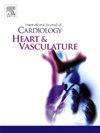Coronary artery calcifications are not associated with epicardial adipose tissue volume and attenuation on computed tomography in 1,945 individuals with various degrees of glucose disorders
IF 2.5
Q2 CARDIAC & CARDIOVASCULAR SYSTEMS
引用次数: 0
Abstract
Background
The quantification of coronary artery calcifications (CAC) is a mainstay in radiological assessment of coronary atherosclerosis and cardiovascular risk, but reflect advanced, possibly late-stage changes in the arteries. Increased volume and changes in attenuation of the epicardial adipose tissue (EAT) on computed tomography (CT) have been linked to adverse cardiovascular events, and these changes in the EAT might reflect earlier stages of the processes leading to clinically manifest atherosclerosis. The relationship between EAT and CAC is subject to a knowledge gap, especially in individuals with no previously known coronary artery disease.
Methods
Fully automated EAT analysis with an artificial intelligence-based model was performed in a population sample enriched for pre-diabetics, comprising a total of 1,945 individuals aged 50–64 years, where non-contrast CT images, anthropometric and laboratory data was available on established cardiovascular risk factors. Uni- and multivariable linear regression, gradient-boosting and correlation analyses were performed to determine the explanatory value of EAT volume and attenuation data with regards to CAC data.
Results
Neither EAT volume nor EAT attenuation was associated with the presence or severity of CAC, when adjusting for established cardiovascular risk factors, and had only weak explanatory value in gradient-boosting and correlation analyses. Age was the strongest predictor of CAC in both sexes.
Conclusion
No independent association was found between CAC and total EAT volume or attenuation. Importantly, these findings do not rule out early stage or local effects on coronary atherosclerosis from the EAT immediately surrounding the coronary arteries.
求助全文
约1分钟内获得全文
求助全文
来源期刊

IJC Heart and Vasculature
Medicine-Cardiology and Cardiovascular Medicine
CiteScore
4.90
自引率
10.30%
发文量
216
审稿时长
56 days
期刊介绍:
IJC Heart & Vasculature is an online-only, open-access journal dedicated to publishing original articles and reviews (also Editorials and Letters to the Editor) which report on structural and functional cardiovascular pathology, with an emphasis on imaging and disease pathophysiology. Articles must be authentic, educational, clinically relevant, and original in their content and scientific approach. IJC Heart & Vasculature requires the highest standards of scientific integrity in order to promote reliable, reproducible and verifiable research findings. All authors are advised to consult the Principles of Ethical Publishing in the International Journal of Cardiology before submitting a manuscript. Submission of a manuscript to this journal gives the publisher the right to publish that paper if it is accepted. Manuscripts may be edited to improve clarity and expression.
 求助内容:
求助内容: 应助结果提醒方式:
应助结果提醒方式:


